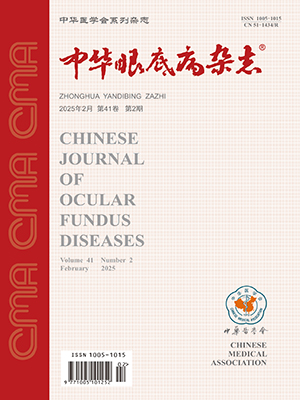| 1. |
Takabatake M, Higashide T, Udagawa S, et al. Postoperative changes and prognostic factors of visual acuity, metamorphopsia and aniseikonia after vitrectomy for epiretinal membrane[J]. Retina, 2017, 38(11): 2118-2127. DOI: 10.1097/IAE.0000000000001831.
|
| 2. |
Schumann RG, Gandorfer A, Ziada J, et al. Hyalocytes inidiopathic epiretinal membranes: a correlative light and electron microscopic study[J]. Graefe's Arch Clin Exp Ophthalmol, 2014, 252(12): 1887-1894. DOI: 10.1007/s00417-014-2841-x.
|
| 3. |
Cho KH, Park SJ, Cho JH, et al. Inner-retinal irregularity index predicts postoperative visual prognosis in idiopathic epiretinal membrane[J]. Am J Ophthalmol, 2016, 168: 139-149. DOI: 10.1016/j.ajo.2016.05.011.
|
| 4. |
Hwang JU, Sohn J, Moon BG, et al. Assessment of macular function for idiopathic epiretinal membranes classified by spectral-domain optical coherence tomography[J]. Invest Ophthalmol Vis Sci, 2012, 53(7): 3562-3569. DOI: 10.1167/iovs.12-9762.
|
| 5. |
Govetto A, Lalane RA III, Sarraf D, et al. Insights into epiretinal membranes: presence of ectopic inner foveal layers and a new optical coherence tomography staging scheme[J]. Am J Ophthalmol, 2017, 175: 99-113. DOI: 10.1016/j.ajo.2016.12.006.
|
| 6. |
郑玥, 项振扬, 杨友谊, 等. 异常中心凹内层对特发性黄斑前膜术后视力的预测价值研究[J]. 中国眼耳鼻喉科杂志, 2021, 21(1): 9-15. DOI: 10.14166/j.issn.1671-2420.2021.01.004.Zheng Y, Xiang ZY, Yang YY, et al. Predictive value of ectopic inner foveal layers for visual acuity after idiopathic macular epiretinal membrane surgery[J]. Chin J Ophthalmol and Otorhinolaryngol, 2021, 21(1): 9-15. DOI: 10.14166/j.issn.1671-2420.2021.01.004.
|
| 7. |
Govetto A, Virgili G, Rodriguez FJ, et al. Functional and anatomical significance of the ectopic inner foveal layers in eyes with idiopathic epiretinal membranes surgical results at 12 months[J]. Retina, 2019, 39(2): 347-357. DOI: 10.1097/IAE.0000000000001940.
|
| 8. |
Pournaras CJ, Donati G, Brazilikos PD, et al. Macular epiretinal membranes[J]. Semin Ophthalmol, 2000, 15(2): 100-107. DOI: 10.3109/08820530009040000.
|
| 9. |
Hashimoto Y, Saito W, Saito M, et al. Retinal outer layer thickness increases after vitrectomy for epiretinal membrane and visual improvement positively correlates with photoreceptor outer segment length[J]. Graefe's Arch Clin Exp Ophthalmol, 2014, 252(2): 219-226. DOI: 10.1007/s00417-013-2432-2.
|
| 10. |
Shiono A, Kogo J, Klose G, et al. Photoreceptor outer segment length: a prognostic factor for idiopathic epiretinal membrane surgery[J]. Ophthalmology, 2013, 120(4): 788-794. DOI: 10.1016/j.ophtha.2012.09.044.
|
| 11. |
Joe SG, Lee KS, Lee JY, et al. Inner retinal layer thickness is the major determinant of visual acuity in patients with idiopathi epiretinal membrane[J/OL]. Acta Ophthalmol, 2013, 91(3): e24-243[2012-12-31]. https://pubmed.ncbi.nlm.nih.gov/23280145/. DOI: 10.1111/aos.12017.
|
| 12. |
Okamoto F, Sugiura Y, Okamoto Y, et al. Inner nuclear layer thickness as a prognostic factor for metamorphopsia after epiretinal membrane surgery[J]. Retina, 2015, 35(10): 2107-2114. DOI: 10.1097/IAE.0000000000000602.
|
| 13. |
Lee EK, Yu HG. Ganglion cell-inner plexiform layer thickness after epiretinal membrane surgery a spectral-domain optical coherence tomography study[J]. Ophthalmology, 2014, 121(8): 1579-1587. DOI: 10.1016/j.ophtha.2014.02.010.
|
| 14. |
Park SW, Byon IS, Lee JE, et al. Analysis of the ganglion cell layer and photoreceptor layer using optical coherence tomography after idiopathic epiretinal membrane surgery[J]. Graefe's Arch Clin Exp Ophthalmol, 2015, 253(10): 1829-1830. DOI: 10.1007/s00417-014-2684-5.
|
| 15. |
Yang HS, Kim JT, Joe SG, et al. Postoperative restoration of foveal inner retinal configuration in patients with epiretinal membrane and abnormally thick inner retina[J]. Retina, 2015, 35(1): 111-119. DOI: 10.1097/IAE.0000000000000276.
|
| 16. |
Song SJ, Lee MY, Smiddy WE. Ganglion cell layer thickness and Visual improvement after epiretinal membrane surgery[J]. Retina, 2016, 36(2): 305-310. DOI: 10.1097/IAE.0000000000000705.
|
| 17. |
González-Saldivar G, Berger A, Wong D,et al. Ectopic inner foveal laryer classification scheme predicts visual outcomes after epiretinal membrane surgery[J]. Retina, 2020, 40(4): 710-717. DOI: 10.1097/IAE.0000000000002486.
|




